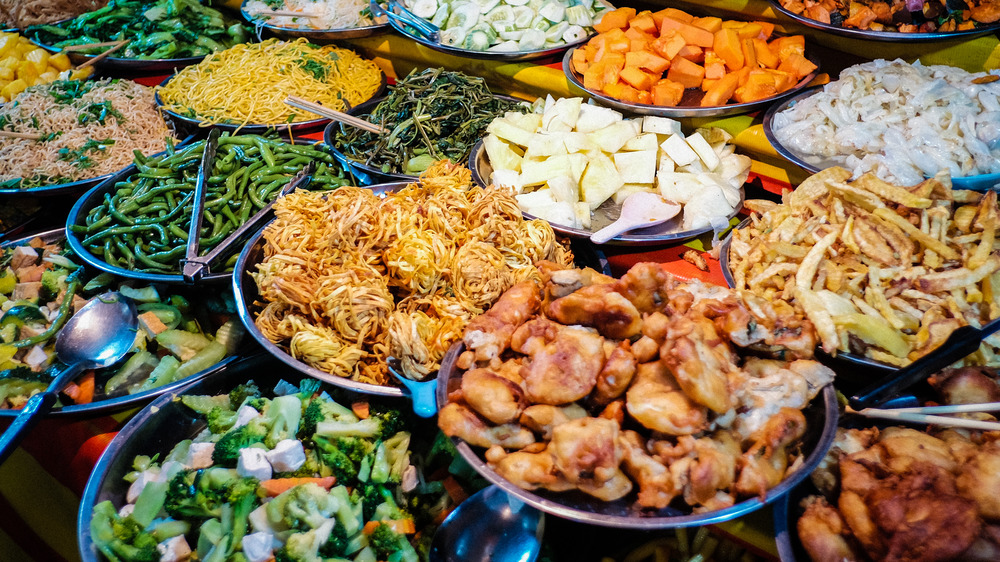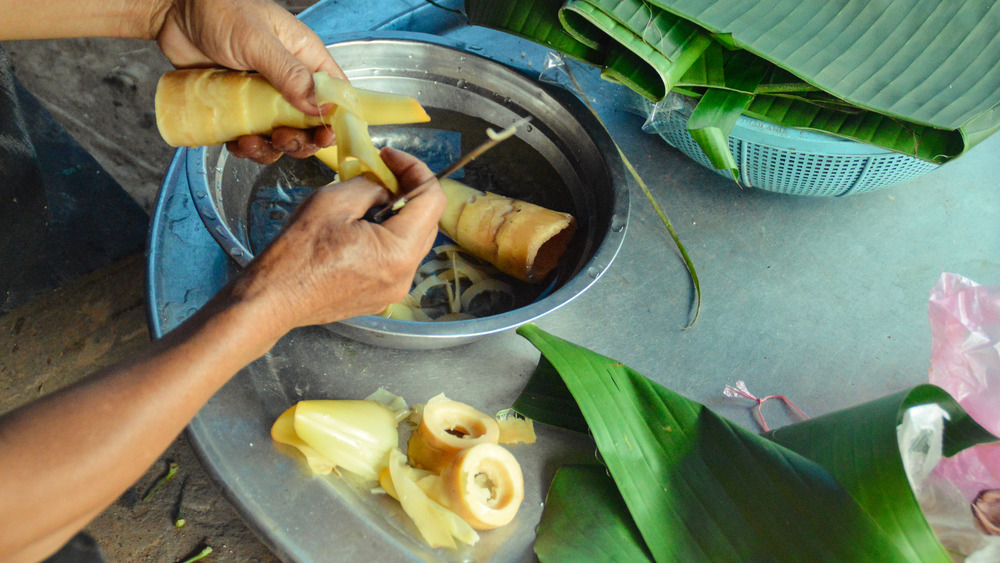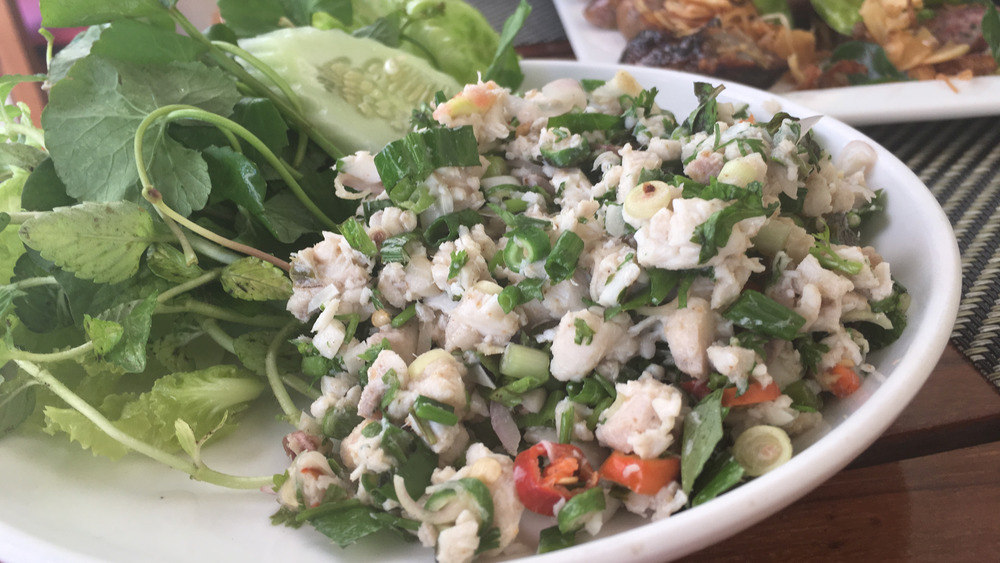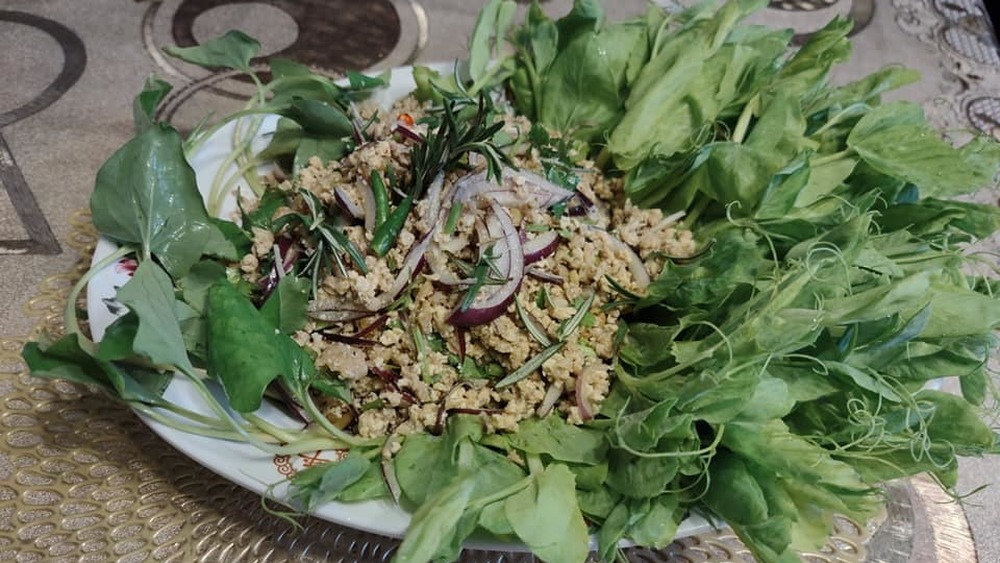The Major Differences Between Thai And Laotian Food
While many people in America are familiar with Thai food, or at least its "greatest hits" such as pad Thai and panang curry, fewer people have tried Laotian food. The two countries share a border, much of it consisting of the Mekong River (via Google Maps), but very different histories, particularly throughout the late 20th century. During the Vietnam War, Thailand was a U.S. ally, while most of Laos was controlled by the communist Pathet Lao allied with the North Vietnamese Army (via The Rand Corporation).
Rather than being a gratuitous history lesson, the above info is actually relevant to why Thai food is available all over the U.S. whereas Laotian takeout has yet to take off. As Cooking With Lane explains it (Lane herself being a Laotian of Vietnamese descent who spent time in a Thai refugee camp), many Thai immigrants came over to the U.S. with the money, resources, and training to open restaurants, while numerous Laotians came instead as refugees. U.S. involvement in the area may have ended with the Fall of Saigon in 1975 (via the History Channel), but the repercussions on those left in-country continued for decades to come.
According to Countries and Cultures, Laotian immigration continued in significant numbers into the 1990s. What's more, much of the Laotian population remains economically disadvantaged even today, undoubtedly impacting their ability to open restaurants. If you live in an area with a significant Lao population, though, you owe it to yourself to seek out the culinary gem that is Laotian cuisine.
Ingredients and preparation methods differ for Laotian and Thai food
Lane (of the above-mentioned Cooking with Lane) explains that while Laotian food, like the Laotian language and culture, has many similarities to its Thai counterpart, it also has some significant differences. For one thing, she says many Thai dishes need to be simmered for hours at a time, while Laotian foods can be prepared far more quickly (typically ready in under an hour). For another, she says Thai dishes often have a coconut milk base, whereas it is far more typical for Laotian food to use a type of fermented fish paste called padaek. Thai food is also most often served with white rice, while Laotian food is usually accompanied by sticky rice.
In Lane's opinion, Laotian food is probably the healthier of the two cuisines. This is because it tends to use more fresh vegetables which are not cooked for too long. The vegetables used in Thai food, on the other hand, may be boiled for a very long time, something dietitian Elaine Magee (via CNN Health) warns may allow vital nutrients to leach out into the cooking water.
These are the most popular Laotian dishes
While you may not be able to find a restaurant advertising Laotian cuisine, there are often Laotian dishes on the menus of Thai restaurants in areas where there is a sizable Laotian population. In fact, Cooking with Lane reveals that Laotian restaurateurs will actually brand their food as "Thai" on order to appeal to customers more familiar with the latter. What's more, Every Culture points out that the cuisine of northeastern Thailand is "almost identical to that of Laos," so if you can find a Thai restaurant offering food from that region, it may well be Laotian.
If you've never tried Laotian food, Lane suggests papaya salad as a great "starter" dish. While Thai cuisine also has a version of this dish, they do differ slightly in that the Thai salad is made with fermented shrimp paste whereas padaek is used to make the Laotian salad. Another popular Laotian dish is a delicious, spicy-sour minced meat salad called larb (or perhaps laarb, laab, or lap), seasoned with lime, cilantro, and mint. You may also like a red curry-based noodle soup that goes by the name of khao poon (or kapoon, khaub poob, ca poon, or kao poon) nam gai. This soup does contain coconut milk (it's not entirely unknown in Laotian kitchens, just used less often than in Thai cooking) as well as chile paste, lemon grass, shallots, and some type of meat such as chicken or pork.
Hmong food has its own traditions
In Minnesota, California, and Wisconsin, many of the Laotian immigrants are actually from the Hmong tribe. According to the Migration Policy Institute, many Hmong refugees had to spend a number of years in Thai refugee camps after fleeing Laos in the aftermath of the Vietnam War. (The Hmong, an ethnic minority in Laos, had, for the most part, supported CIA covert operations aimed at defeating the Pathet Lao). Given such a long exile, their cuisine reflects that of both Thailand and Laos, although it has unique elements of its own.
Dara Kasouaher, who spoke with Heavy Table about Hmong cooking, was born in Milwaukee, but her family arrived in the U.S. in 1976, Not only did many Hmong immigrants bring with them their cooking traditions, but they often managed to smuggle something else out of the camps...seeds used to grow special herbs unavailable in America. Hmong cooking favors fresh ingredients, but relies to a high degree on adaptability as well – papaya salad is a favorite snack, but in the absence of green papaya (not too common in the 1970s Upper Midwest), Hmong cooks created a version using shredded carrots or cucumber. Other unique Hmong dishes include nqaij qaib hau xyaw tshuaj, a chicken soup traditionally served to new mothers, and dib iab ntim nqaij hau ua kua, a soup made from bitter melon (via Cooking from the Heart). Luckily for Hmong cooks, the latter ingredient is now readily available at Asian markets.



